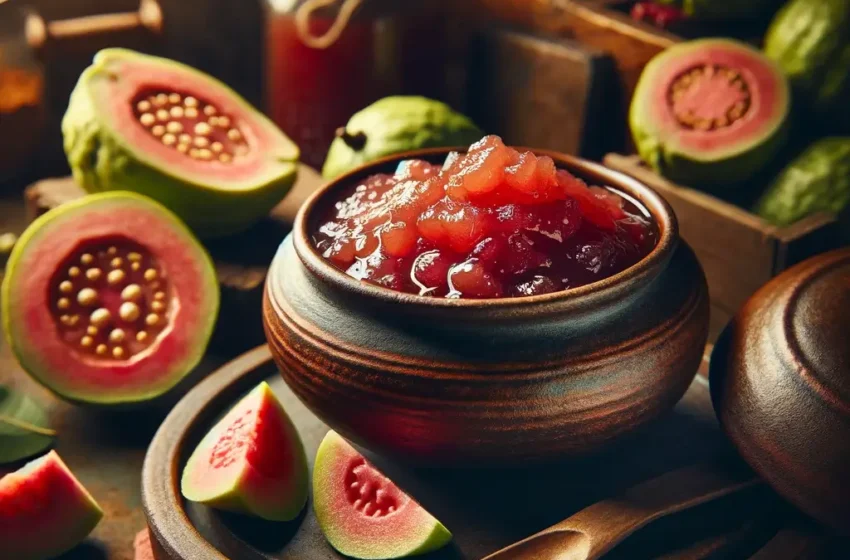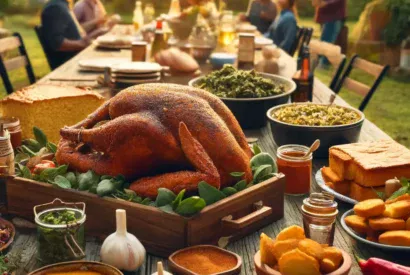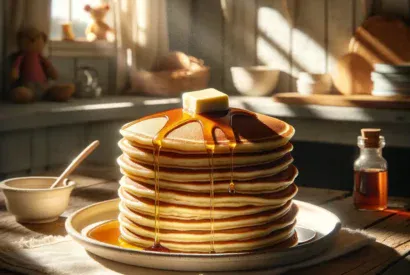Introduction to Guava Paste
As a food reviewer who has tasted myriad delicacies, I can confidently say that Guava Paste stands out for its unique blend of sweetness and tanginess, making it a versatile ingredient in various dishes. Originating from Latin America, this delightful concoction is a thick, sweet paste made from guava fruit and sugar, often enhanced with a hint of lemon or lime juice to balance the sweetness. It’s commonly used in desserts, paired with cheese, or enjoyed as a spread on toast. The rich, concentrated flavor of guava in this paste is truly unparalleled, offering a taste of tropical indulgence with each bite.
How to Make Delicious Homemade Guava Paste: A Simple and Flavorful Recipe
- Preparation Time
30 minutes - Cooking Time
1-1.5 hours - Serves
4 adults - Difficulty
Easy
Ingredients
- 1 kg (about 2.2 pounds) of ripe guavas
- 1-1.5 cups of sugar (adjust based on the sweetness of the guavas and personal preference)
- Juice of 1 lemon (optional, to balance the sweetness)
- Water (enough to cover the guavas for boiling)
Equipment
- Large pot
- Strainer or sieve
- Blender or food processor
- Shallow tray or dish
Instructions
- Step 1: Prepare the Guavas
- Wash the guavas thoroughly.
- Cut them into halves and remove the seeds. The seeds are hard and can cause bitterness if not removed properly.
- Step 2: Boil the Guavas
- Place the guava halves in a large pot and add enough water to cover them.
- Bring to a boil and simmer until the guavas are soft, about 15-20 minutes.
- Step 3: Blend the Guavas
- Drain the guavas and allow them to cool slightly.
- Blend the guavas in a blender or food processor until smooth.
- Step 4: Cook the Guava Puree
- Pass the guava puree through a strainer or sieve to remove any remaining seeds or lumps.
- Measure the puree and pour it back into the pot. Add an equal amount of sugar (1 cup of sugar for every cup of guava puree).
- Add the lemon juice, if using.
- Cook over medium heat, stirring frequently, until the mixture thickens and darkens in color, about 30-60 minutes.
- Step 5: Set the Guava Paste
- Once the mixture has thickened and can be seen pulling away from the sides of the pot, pour it into a lightly greased shallow tray or dish.
- Allow it to cool and set, either at room temperature or in the refrigerator.
Pro Tips for Guava Paste Recipe
- Selecting Guavas: Use ripe guavas for the best flavor. They should be soft to the touch and have a sweet aroma.
- Adjusting Sweetness: Taste the guava puree before adding sugar and adjust the amount based on your preference and the sweetness of the fruit.
- Thickness: The longer you cook the mixture, the thicker your guava paste will be. For a softer paste, cook for less time.
How to Enjoy Guava Paste
Guava paste can be enjoyed in numerous ways:
- As a dessert, served with cheese (especially cream cheese or a mild white cheese).
- Spread on toast or crackers.
- Used as a filling for pastries or cakes.
Why You Will Love Guava Paste Recipe
- Simple Ingredients: Requires only a few, easily accessible ingredients.
- Versatility: Perfect for sweet and savory dishes alike.
- Long Shelf Life: Can be stored and enjoyed over time.
- Unique Flavor: Offers a taste of the tropics that’s hard to find in other foods.
Conclusion
Homemade guava paste is not just a recipe; it’s a delightful journey to a tropical paradise through your taste buds. Its versatility and unique flavor profile make it a must-try for anyone looking to explore new culinary territories. If you’ve enjoyed this delicious homemade guava paste recipe, don’t hesitate to share it with your friends and family. They’ll thank you for introducing them to this exquisite treat!
You can also read :-Grinder Salad Recipe
FAQs on Homemade Guava Paste Recipe
1. What is guava paste?
Guava paste is a thick, sweet confection made from guava fruit and sugar, often with added lemon juice. It’s commonly used in desserts and pairs excellently with cheese.
2. How long does homemade guava paste last?
When stored in an airtight container in the refrigerator, homemade guava paste can last up to 3 months.
3. Can guava paste be frozen?
Yes, guava paste freezes well. Wrap it tightly in plastic wrap and store it in a freezer bag for up to 6 months.
4. Is guava paste vegan?
Yes, traditional guava paste is vegan as it typically contains only guava, sugar, and lemon juice.
5. Can I use canned guavas to make guava paste?
While fresh guavas are preferred for their flavor, canned guavas can be used as a convenient alternative.
6. How do I know when the guava paste is ready?
The guava paste is ready when it’s thick enough to pull away from the sides of the pot and darkens in color.
7. Can I make guava paste without sugar?
Sugar is essential for the texture and preservation of guava paste, but you can experiment with sugar substitutes like honey or maple syrup. However, the final texture may vary.
8. Why do I need to remove the seeds from the guavas?
Guava seeds are hard and can introduce bitterness to the paste. Removing them ensures a smooth, pleasant texture.
9. Can I add other flavors to my guava paste?
Absolutely! Experiment with adding vanilla, cinnamon, or even a splash of rum to customize your guava paste.
10. Is guava paste gluten-free?
Yes, guava paste is naturally gluten-free as it does not contain any wheat or gluten-containing ingredients.
11. Why is my guava paste too hard?
If your guava paste is too hard, it was likely cooked for too long. You can soften it by reheating with a bit of water.
12. Can I use unripe guavas for this recipe?
Unripe guavas may lack the sweetness and flavor profile necessary for a delicious guava paste. It’s best to use ripe guavas.
13. How can I use guava paste in baking?
Guava paste can be used as a filling for cakes, pastries, and cookies or as a topping for cheesecakes and tarts.
14. What cheese pairs well with guava paste?
Cream cheese, queso blanco, and brie are excellent choices to pair with guava paste.
15. Why does my guava paste taste bitter?
Bitterness can result from not fully removing the seeds or from using underripe guavas.
16. Can I reduce the sugar in the recipe?
Yes, but keep in mind that sugar helps with preservation and texture. Reducing it might affect both the taste and shelf life.
17. How can I achieve a smoother texture?
Ensure to blend the guava thoroughly and strain it well to remove any fibers and seeds.
18. Can I make guava paste with other fruits?
While guava paste is unique, you can apply the same technique to make pastes from fruits like mango or pineapple.
19. What’s the best way to store guava paste?
Store it in an airtight container in the refrigerator to maintain its freshness and prevent it from drying out.
20. Why is my guava paste not setting?
If it’s not setting, it may not have been cooked long enough to reach the correct consistency. Return it to the heat and cook it longer.
21. Can I make guava paste without lemon juice?
Yes, but lemon juice helps balance the sweetness and adds a slight tanginess. Without it, the paste may be overly sweet.
22. How do I know if the guavas are ripe enough?
Ripe guavas are slightly soft to the touch and emit a fragrant, sweet aroma.
23. Can I use brown sugar instead of white sugar?
Yes, brown sugar will add a deeper, molasses-like flavor to your guava paste.
24. What’s the difference between guava paste and guava jelly?
Guava paste is thicker and more concentrated, while guava jelly is softer and more spreadable.
25. Can guava paste be used as a jam?
Yes, it can be used as a spread on bread, toast, or crackers, much like jam.
26. How thick should I pour the guava paste into the tray for setting?
A thickness of about 1-2 inches is ideal, allowing for easy cutting and handling once set.
27. What do I do if my guava paste is too sweet?
Balance the sweetness by adding a bit more lemon juice, or use it in recipes that pair with savory or tangy elements.
28. Can I make guava paste in a slow cooker?
Yes, a slow cooker can be used to simmer the guava and sugar mixture on low, though it may take longer to achieve the desired thickness.
29. How can I tell the difference between guava paste and guava cheese?
Guava cheese is similar to guava paste but has a softer, more fudgy texture and is often made with added milk.
30. Can I use guava paste in drinks?
Yes, guava paste can be melted down and mixed into cocktails or smoothies for a tropical flavor boost.












